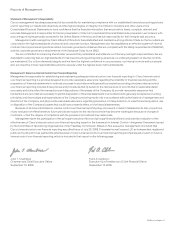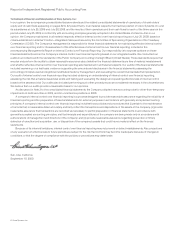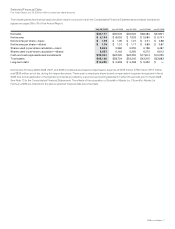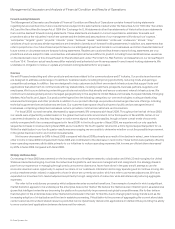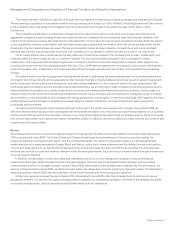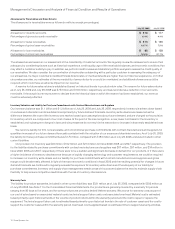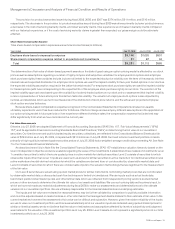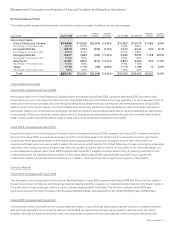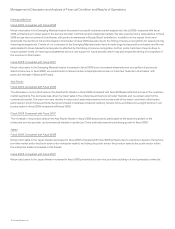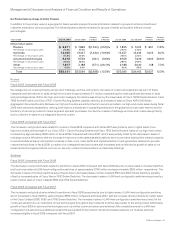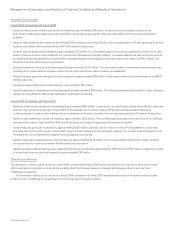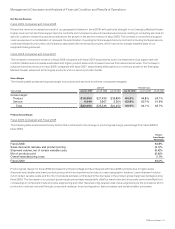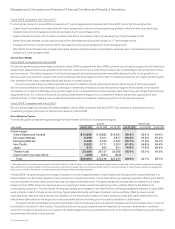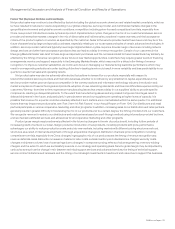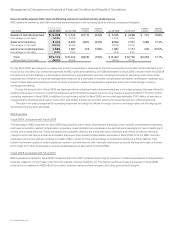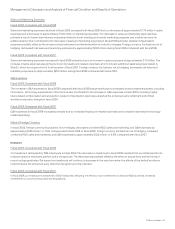Cisco 2009 Annual Report Download - page 17
Download and view the complete annual report
Please find page 17 of the 2009 Cisco annual report below. You can navigate through the pages in the report by either clicking on the pages listed below, or by using the keyword search tool below to find specific information within the annual report.Management’s Discussion and Analysis of Financial Condition and Results of Operations
Significant judgment is required in evaluating our uncertain tax positions and determining our provision for income taxes. Although we
believe our reserves are reasonable, no assurance can be given that the final tax outcome of these matters will not be different from that
which is reflected in our historical income tax provisions and accruals. We adjust these reserves in light of changing facts and
circumstances, such as the closing of a tax audit or the refinement of an estimate. To the extent that the final tax outcome of these matters is
different than the amounts recorded, such differences will impact the provision for income taxes in the period in which such determination
is made. The provision for income taxes includes the impact of reserve provisions and changes to reserves that are considered
appropriate, as well as the related net interest.
Significant judgment is also required in determining any valuation allowance recorded against deferred tax assets. In assessing the
need for a valuation allowance, we consider all available evidence, including past operating results, estimates of future taxable income, and
the feasibility of tax planning strategies. In the event that we change our determination as to the amount of deferred tax assets that can be
realized, we will adjust our valuation allowance with a corresponding impact to the provision for income taxes in the period in which such
determination is made.
Our provision for income taxes is subject to volatility and could be adversely impacted by earnings being lower than anticipated in
countries that have lower tax rates and higher than anticipated in countries that have higher tax rates; by changes in the valuation of our
deferred tax assets and liabilities; by expiration of or lapses in the R&D tax credit laws; by transfer pricing adjustments including the effect
of acquisitions on our intercompany R&D cost sharing arrangement and legal structure; by tax effects of nondeductible compensation; by
tax costs related to intercompany realignments; by changes in accounting principles; or by changes in tax laws and regulations including
possible U.S. changes to the taxation of earnings of our foreign subsidiaries, the deductibility of expenses attributable to foreign income,
or the foreign tax credit rules. Significant judgment is required to determine the recognition and measurement attribute prescribed in FASB
Interpretation No. 48, “Accounting for Uncertainty in Income Taxes —an interpretation of FASB Statement No. 109” (“FIN 48”). FIN 48 applies
to all income tax positions, including the potential recovery of previously paid taxes, which if settled unfavorably could have an adverse
impact on our provision for income taxes or additional paid-in capital. Further, as a result of certain of our ongoing employment and capital
investment actions and commitments, our income in certain countries is subject to reduced tax rates and in some cases is wholly exempt
from tax. Our failure to meet these commitments could adversely affect our provision for income taxes. In addition, we are subject to the
continuous examination of our income tax returns by the Internal Revenue Service (“IRS”) and other tax authorities. We regularly assess the
likelihood of adverse outcomes resulting from these examinations to determine the adequacy of our provision for income taxes. There can
be no assurance that the outcomes from these continuous examinations will not have an adverse impact on our operating results and
financial condition.
Loss Contingencies
We are subject to the possibility of various losses arising in the ordinary course of business. We consider the likelihood of loss or
impairment of an asset or the incurrence of a liability, as well as our ability to reasonably estimate the amount of loss, in determining loss
contingencies. An estimated loss contingency is accrued when it is probable that an asset has been impaired or a liability has been
incurred and the amount of loss can be reasonably estimated. We regularly evaluate current information available to us to determine
whether such accruals should be adjusted and whether new accruals are required.
Third parties, including customers, have in the past and may in the future assert claims or initiate litigation related to exclusive patent,
copyright, trademark, and other intellectual property rights to technologies and related standards that are relevant to us. These assertions
have increased over time as a result of our growth and the general increase in the pace of patent claims assertions, particularly in the
United States. If any infringement or other intellectual property claim made against us by any third party is successful, or if we fail to
develop non-infringing technology or license the proprietary rights on commercially reasonable terms and conditions, our business,
operating results, and financial condition could be materially and adversely affected.
Reclassifications
During fiscal 2009, we began to allocate certain costs, which had previously been recorded in general and administrative expenses (related
to information technology, our financing business, and human resources), to sales and marketing expenses, R&D expenses, and cost of
sales, as applicable. These changes were reflected accordingly in prior years for comparison purposes. In connection with these changes,
we also reclassified gross margin amounts by theater in prior years. In addition, we have made certain reclassifications to amounts for prior
years relating to net sales by theater and net product sales by groups of similar products due to refinement of the respective categories, in
order to conform to the current year’s presentation.
2009 Annual Report 15


